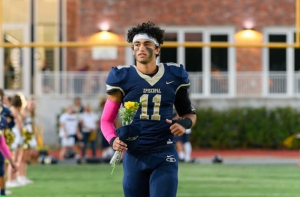The Splash Page: “Detective Comics” #1000 remembers what’s great about Batman

Photo courtesy of Wikimedia Commons
April 19, 2019
In the world of DC Comics, there are infinite realities, each one humming to its own vibrational frequency. One – the one we care about – is a chord made of the musical notes D and C. But that’s not the reason it’s called DC Comics, just a side effect. The “D” stands for Detective and the “C” for Comics. (Yes, DC Comics is literally Detective Comics Comics.) The series from which the company gets its name – “Detective Comics” – has been running longer than any other of their publications, including “Action Comics,” home of Superman and birthplace of superheroes. Batman didn’t appear until “Detective Comics” #27, and now, 80 years later and 973 issues later, “Detective Comics” #1000 has flown into comic book stores and on to newsstands.
I had a visceral reaction to “Action Comics” #1000 last year (“Action,” despite premiering second, has had more issues because it has been published as a bi-weekly book instead of a monthly for longer stretches). There was something about holding that book in my hands that drew me back to 1938, that reminded me of who Superman was, who he always had been and always would be. I don’t have that same reaction to this issue of “Detective Comics,” maybe because Batman didn’t premiere until #27, maybe because “Detective Comics,” despite being one of the few books in the industry that have been publishing since the dawn of superheroes, isn’t the book that brought superheroes as we know them into the world like “Action” did. Maybe it’s because I have a connection to Superman I’ve never had with Batman, because I always wanted to be Superboy and never really thought about being Robin. Nevertheless, “Detective” #1000 is good. Like “Action” last year, it’s a series of stories, some in continuity, some not, that attempt to tell us who Batman is. I like this issue’s answer, and I think it says something about where Detective Comics Comics is as a company right now, and the where the comic book industry is headed. Zack Snyder, director of “Batman V. Superman: Dawn of Justice” and “Justice League”, said this week that if fans didn’t think Batman and Superman were killers, then they needed to grow up, though in more words and vulgarities than that, and laid out a vision of superheroes, and Batman in particular, as somehow needing to reflect the “real” world, where violence is a necessity and crime must be punished in the harshest ways.
That’s not the Batman of this issue, and certainly not my Batman. This issue doesn’t attempt to recap the entire history of the Caped Crusader, or even to reference every version of him, but instead focuses on stories that frame the World’s Greatest Detective as just that. “Detective Comics,” as the name suggests, has tended over the years to be the book about Batman as vigilante and sleuth, and “Batman” has been the book about his super heroics. In keeping with that tradition, we’re met with stories about Batman planning ahead, about his brilliant mind and sense of curiosity. It’s an aspect of the character that is sometimes forgotten, but time after time in this issue we see a Bruce Wayne who thinks two steps ahead.
More importantly, however, and perhaps more informative, are the stories about the Bat-Family. The penultimate tale in this issue is about the one case Batman could never solve – the murder of his parents. Even finding their killer, that nefarious Joe Chill, has been unsatisfactory to the Dark Knight. It was the violence, the senseless violence of Gotham City, that killed his parents, not a single man. But Tom King, whose ongoing run on “Batman” has had both high and low points, gives us the answer to the mystery of the violence. In the end, Batman stands with his family, biological and adopted, and reveals that the answer to the darkness that created the Batman is looking back at it with love and compassion. This is not a new idea. Nightwing, the grown-up Robin, has always been the boy who saw his parents murdered and could have become as dark as Bruce but didn’t, because Bruce took him in and gave him love and a purpose.
This version of the Bat-Family, as a kind of end to Batman, has become the prevailing view of the character in recent years. Once, in the 1980s, Batman’s crusade ended in blood and mud and political confrontations in the pages of Frank Miller’s’ “Dark Knight Returns.” Now, his crusade hasn’t ended, but it has changed. He’s in a strange place as a character, a place where, after 80 years, he has solved his greatest mystery and vanquished his greatest foe. The last story in this book teases a confrontation with new villain, the Arkham Knight, who intriguingly finds fault in the way in which Batman has spread his family across Gotham and will perhaps challenge the status quo in interesting ways.
This vision of Batman reflects a superhero industry that has finally, totally, come around from the darkness of the 1980s, spawned by works like “Dark Knight Returns” and “Watchmen,” which have both been responded to in recent months with this retelling of what make the Batman work and DC’s ongoing Watchmen sequel “Doomsday Clock”, that pits the DC Universe against the machinations of a cynical Dr. Manhattan. Zack Snyder directed the “Watchmen” adaptation, too, and it’s this vision of the DC Universe that has been with us for too long, this vision that prevailed even into the DC Movie Universe.
But in recent years DC Comics, and the industry as a whole, have moved towards versions of their universes that focus, once again, on the goodness of their characters. Batman is a good guy; he does not kill because he fights with metaphor in his fists, because his greatest accomplishment is not foiling crime in Gotham but in building a family who do not have to live the life he did. “Detective Comics” #1000 stands out not just as a celebration of Batman, but as a signpost in what Batman, and what superheroes, mean in 2019. They are more than vigilantes, we have learned, more than killers and vengeful people. Superheroes, finally, are cool again, and that means we – and Detective Comics – can allow them to be full people, with problems and worries and foibles but who still serve as metaphors for the act of overcoming or rising above. Batman has long been about rising above trauma, and this landmark issue lets him finally get that. After 80 years, it feels like Batman is whole. This is my Batman, and I’m hoping we get a thousand more issues of that.









![NEWS | The University of Alabama issued guidelines for faculty that align with the passage of SB129, a controversial Alabama state law that, among other things, restricts DEI policies and prohibits endorsements of “divisive concepts.” These new guidelines highlight potential interactions with “divisive concepts” and formalize a new list of do’s and don’ts for classroom discussion and instruction.
From the start of the fall semester, SB129’s impact could be felt across campus, from the changes to funding for student organizations to the shuttering of the Safe Zone and offices of the Black Student Union. These outcomes were the result of SB129’s anti-DEI sections, preventing the University from sponsoring or promoting any DEI programs. The consequences of SB129’s “divisive concept” restrictions were more uncertain, however.
“[SB129] is vague, and what its implications will actually look like are not totally clear,” said Beth Ann Powers, an associate member in the University of Cincinnati Law Review.
Read the full story at the link in our bio.
📸 CW / Riley Thompson
🖊️ CW / Benjamin Smith
#theuniversityofalabama #universityofalabama #alabama #uofa #ua #crimsontide #tuscaloosa #tuscaloosaalabama #alabama #bama](https://thecrimsonwhite.com/wp-content/plugins/instagram-feed/img/placeholder.png)